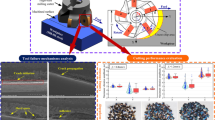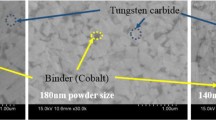Abstract
This paper investigates and compares the machining characteristics of AISI H13 tool steel in hardness states of 41 and 20 HRC in the ball end milling process. The machining characteristics are illustrated through three types of process outputs from the milling experiments: the milling force, the chip form, and the surface roughness. Characteristic differences in these process outputs are shown to reflect the hardness effect of the tool steel on the ball end milling process. The mechanistic phenomena of the milling process are revealed by the six shearing and ploughing cutting constants extracted from the milling forces. The experimental results show that all the cutting constants of the softer tool steel are greater than those of the hard steel, indicating that higher cutting and frictional energies are required in the chip shearing as well as in the nose ploughing processes of the softer tool steel. The higher cutting energy is also attested by the more severely deformed, shorter, and thicker chips of the softer steel. Surface roughness of the hard steel is shown to be considerably better than that of the soft steel at all cutting speeds and feed rates and is independent of cutting speed, whereas the surface roughness of the softer steel is significantly improved with increasing cutting speed.








Similar content being viewed by others
Abbreviations
- α ο :
-
nominal helix angle at the shank
- df t, df r, df a :
-
differential local cutting forces in the tangential, radial, and axial directions
- ϕ :
-
cutter rotation angle
- h :
-
axial position of cutting point
- k ts, k rs, k as :
-
shearing force constants in the tangential, radial, and axial directions
- k tp, k rp, k ap :
-
ploughing force constants in the tangential, radial, and axial directions
- θ :
-
cutter position in the work
- R o :
-
cutter ball radius
- t ave, t c, t x :
-
average uncut chip thickness, uncut chip thickness and feed per tooth
- t cm :
-
maximum deformed chip thickness
- ψ :
-
elevation angle of cutting point
- γ c :
-
chip compression ratio
References
Liu CR, Barash MM (1982) Variables governing patterns of mechanical residual stress in a machined surface. J Eng Ind 104:257–264
Wu DW, Matsumoto Y (1990) The effect of hardness on residual stress in orthogonal machining of AISI 4340 steel. ASME J Eng Ind 112:245–252
Oishi K (1995) Built-up edge elimination in mirror cutting of hardened steel. ASME J Eng Ind 117:62–66
Elbestawi MA, Srivastava AK, El-Wardany TI (1996) A model for chip formation during machining of hardened steel. Ann CIRP 45:71–76
Vyas A, Shaw MC (1999) Mechanics of saw-tooth chip formation in metal cutting. ASME J Manuf Sci Eng121:163–172
El-Wardany TI, Kishawy HA, Elbestawi MA (2000) Surface integrity of die material in high speed hard machining. Part 1: Microhardness variations and residual stress. ASME J Manuf Sci Eng 122:620–631
El-Wardany TI, Kishawy HA, Elbestawi MA (2000) Surface integrity of die material in high speed hard machining. Part 2: Microhardness variations and residual stress. ASME J Manuf Sci Eng 122:632–641
Thiele JD, Melkote SN, Peascoe RA, Watkins TR (2000) Effect of cutting-edge geometry and workpiece hardness on surface residual stress in finish hard turning of AISI 52100 steel. ASME J Manuf Sci Eng 122:642–649
Poulachon G, Moisan AL (2000) Hard turning: chip formation mechanisms and metallurgical aspects. ASME J Manuf Sci Eng 122:406–412
Ng EG, Aspinwall DK (2002) The effect of workpiece hardness and cutting speed on the machinability of AISI H13 hot work die steel when using PCBN tooling. ASME J Manuf Sci Eng124:588–594
Tonshoff HK, Arendt C, Amor RB (2000) Cutting of hardened steel. Ann CIRP 49(2):547–566
Elbestawi MA, Chen L, Becze CE, El-Wardany TI (1997) High-speed milling of die and molds in their hardened state. Ann CIRP 46:57–62
Urbanski JP, Koshy P, Dewes RC, Aspinwall DK (2000) High speed machining of moulds and dies for net sharp manufacture. Mater Des 21:395–402
Wang JJ, Zheng CM (2002) Identification of shearing and ploughing cutting constants from average forces in ball-end milling. Int J Mach Tools Manuf 42:695–705
Yucesan G, Altintas Y (1996) Prediction of ball end milling forces. ASME J Eng Ind 118:95–103
Budak E, Altintas Y, Armarego EJA (1996) Prediction of milling force coefficients from orthogonal cutting data. ASME J Eng Ind 118:216–224
Zheng CM, Wang JJ (2003) Estimation of in-process cutting constants in ball-end milling. Proc Inst Mech Eng, Part B: J Eng Manuf 217:45–56
Acknowledgments
The authors wish to express their gratitude to the National Science Council of Taiwan for the financial support extended to this research through grant no. NSC-90-2212-E-006-090. Partial financial support, as well as tooling and machinery assistance for the experimental work from Chuan Liang Industrial Co., are also appreciated.
Author information
Authors and Affiliations
Corresponding author
Rights and permissions
About this article
Cite this article
Junz Wang, J.J., Zheng, M.Y. On the machining characteristics of H13 tool steel in different hardness states in ball end milling. Int J Adv Manuf Technol 22, 855–863 (2003). https://doi.org/10.1007/s00170-003-1663-5
Received:
Accepted:
Published:
Issue Date:
DOI: https://doi.org/10.1007/s00170-003-1663-5




